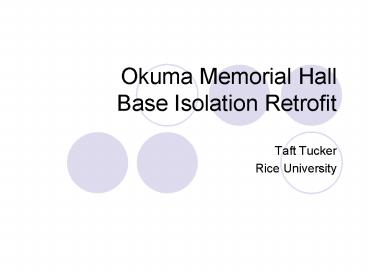Okuma Memorial Hall Base Isolation Retrofit PowerPoint PPT Presentation
1 / 35
Title: Okuma Memorial Hall Base Isolation Retrofit
1
Okuma Memorial HallBase Isolation Retrofit
- Taft Tucker
- Rice University
2
Waseda University
- Founded in 1882 by samurai scholar Okuma
Shigenobu - One of oldest and most prestigious universities
in Japan - About 45,000 undergrads including almost 7,000
Science and Engineering students
3
Okuma Hall
- shortly after Okumas death in 1922 construction
began - Construction delayed by Great Kanto Earthquake
- Construction Completed in 1927
4
Base-Isolation Retrofit
- Would reduce superstructure damage in the event
of earthquake - However, very expensive to retrofit
5
(No Transcript)
6
(No Transcript)
7
Static Analysis
- FEM Model
- Subjected to Japans standard lateral earthquake
loading (Ai Coefficient)
194.5 kN
194.5 kN
194.5 kN
40.5 kN
51 kN
51 kN
123.5 kN
123.5 kN
8
Derivation of Lateral Stiffness
- Used nodal displacements to calculate inter-story
drift and derive lateral stiffness to be used in
dynamic analysis
0.283 in.
9
Earthquake Analysis Fixed Base Case
- Natural period and damping of building was found
by solving eigenvalue problem. T .62 sec. - Subjected building to scaled El Centro earthquake
with max ground acceleration 150 cm/sec2 - Used Linear Acceleration Method to return top
story deflection, velocity, and acceleration and
base shear time-history plots.
10
Dynamic Analysis Results Base Shear
1183 kN
- Max Base Shear 1183 kN
11
Dynamic Analysis Results Shear Coefficients
- First Level 0.30 Second 0.42 Third 0.45
Fourth 0.47
12
Dynamic Analysis Results Deflection
4.22 cm
- Max Deflection 4.22 cm
13
Dynamic Analysis Results Velocity
41.6 cm/s
- Max Velocity 41.6 cm/s
14
Dynamic Analysis Results Acceleration
5.47 m/sec2
- Max Acceleration 5.47 m/sec2
15
Base Isolation Model
- Used multiple degree of freedom model for base
isolation analysis with base stiffness set to
give a period of 3 seconds. - Passive Analysis
- Yield Load Set to 1 of building weight
- Compared with Uncontrolled Case
- Damper Yield Load set to zero
- Scaled El Centro
- 150 cm/sec2 for comparison with fixed base case
16
Passive Control w/ Friction
- Magnetorheological Damper used at isolation level
- Yield load is static value throughout excitation,
passive control - Behavior is similar to passive friction damper
17
Passive Results Top Story Acceleration
- Max Acceleration 0.57 m/sec2
- reduction of 90 compared to fixed base case
18
Passive Results Base Deflection
- Max Base Displacement 5.1 cm
- Decreased from 18.5 cm (72) in No Friction
Damping Case
19
Passive Results by Story
- Acceleration Deflection
- Max 0.57 m/sec2 Max
5.1 cm
20
Passive Results Base Shear
- Max Base Shear 231 kN
- 80 reduction from fixed base case
21
Damper Forces
Yield Force
Yield Force 1 of Building Weight
22
Is passive good for stronger EQ?
-- El Centro -- Taft -?- Hachinohe
- As Earthquake acceleration increases,
effectiveness at reducing deflection decreases.
23
Semi-Active Control
- Used MR damper to vary level of damping on base
of building by changing the yield load of Damper - Yield Load varied by changing electric current
supplied to damper
24
Semi-Active Control Strategy
- Yield Load a x Mass x Absolute Acceleration
- Performed Optimal Alpha Analysis to Decide which
alpha would best reduce both Acceleration and
Deflection - Used Scaled Hachinohe, Taft, and El Centro
Earthquakes - Max Acceleration 500 cm/sec2
25
Semi-Active Control Strategy
- Yield Load a x Mass x Absolute Acceleration
26
Optimal Alpha Analysis Acceleration
0.3
27
Optimal Alpha Analysis Deflection
0.3
28
Semi-Active Control Results Top Story
Acceleration
- Max Acceleration .59 m/sec2
- Roughly equivalent to passive damping
29
Semi-Active Control Results Base Deflection
- Max Deflection 7.5 cm
- Increase of 2.4 cm from Passive Control
30
Semi-Active Control Results by Story
Deflection
Acceleration
31
Semi-Active Control Results Base Shear
- Max Shear 405 kN
- Increase from passive case
32
Base Shear - Active vs. Passive
33
Semi-Active Control Results Damper Forces
34
How does Semi-Active Control Perform in
Larger Earthquakes?
Percentage of Uncontrolled Deflection
35
Conclusions
- Base Isolation would reduce forces in Okuma Hall
during EQ, however displacement is increased
considerably. - Passive control reduces displacement for small
EQ, but does not perform well under larger EQ. - Semi-Active Control should be used to control
deflection in event of large EQ.

